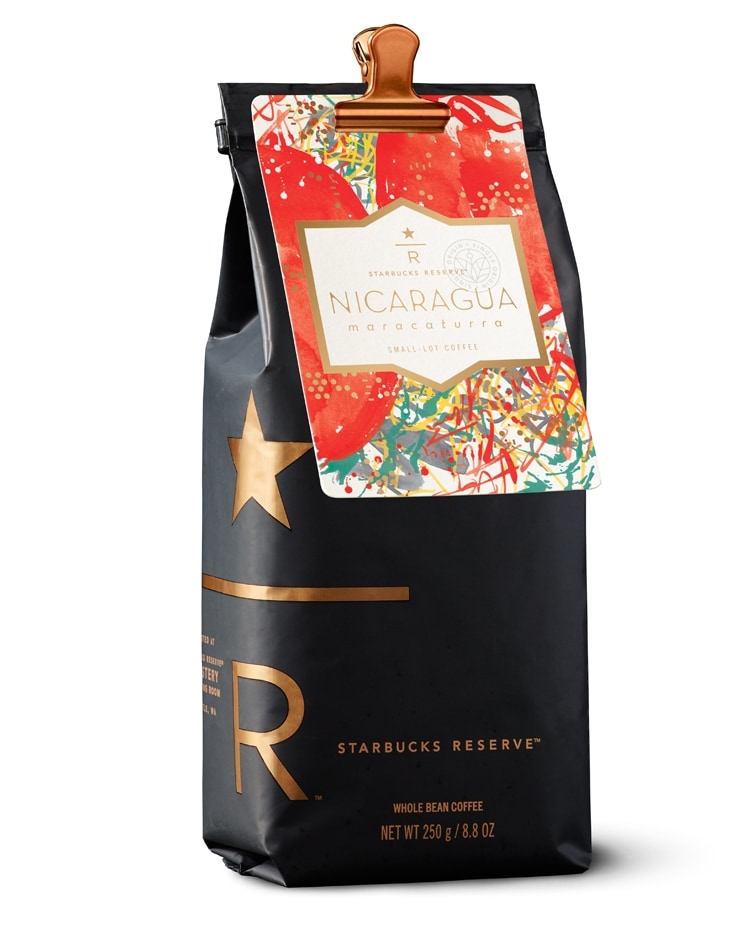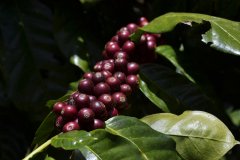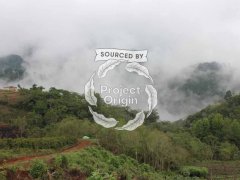Starbucks Nicaraguan Maraka Dula Coffee suggestion for roasting Nicaraguan coffee beans

For professional baristas, please follow the coffee workshop (Wechat official account cafe_style)
Starbucks Nicaraguan Maraka Dula Coffee: the sweetness of red apples is perfectly integrated with charming spicy fruit notes with a cloudy aroma.
The moment you open the Maraka Dura coffee bag, you can immediately feel the beauty of this coffee. The size of this coffee bean is huge, far beyond the average coffee bean. The huge size also helps to give birth to bright, sweet coffee flavor and rich sour aroma. However, contrary to the size of coffee beans, Malakadura's coffee trees are delicate and fragile, thanks to the meticulous care of farmer Luis Emilio Valladarez. Luis Emilio has been operating the Buenos Aires estate since 1955 and received the precious gift of Malakadura seeds, but he soon discovered its unique size and moving flavor, which was definitely worth all the effort to cultivate. He became one of the few local coffee farmers to grow Malakadura and succeeded in making this coffee popular.
Origin: Latin America
Altitude: 1250-1430m
Treatment method: washing method
Taste: spicy fruit and yunnana
Concentration: medium
Acidity: medium
Match flavors: red apple and apple pie
Nicaraguan coffee has excellent quality and taste, and it is also among the top coffee beans in the world and enjoys a good reputation. In terms of flavor characteristics, Nicaraguan coffee has moderate acidity, mild taste and delicious aroma.
Nicaragua is located in central Central America, bordered by the Pacific Ocean to the west and the Caribbean Sea to the east. The highlands in the north and the coastal plains in the east are part of the Central American volcanic belt. The eastern plain is high-temperature and rainy, with a tropical maritime climate. The suitable climate provides an excellent growth environment for the cultivation of coffee.
High-quality Nicaraguan coffee, grown in the north and middle of the country. Coffee is a pillar industry in Nicaragua, producing nearly 100,000 tons of coffee beans every year. Many people who have tasted Nicaraguan coffee usually think that it is no different from Salvadoran coffee or Honduran coffee. It is full-bodied, smooth and delicate, with a slightly bitter finish, like a faint taste in a wine.
When tasting Nicaraguan coffee, you'd better take a sip of cold water first.
To better feel its mellow taste. Drink coffee while it is hot, because the tannins in Nicaraguan coffee are easy to change during cooling, and the taste becomes sour, which will affect the flavor of the coffee. You can add the right amount of sugar, and then add cream.
Enjoy a cup of high-quality Nicaraguan coffee, you can not only experience the different levels of coffee taste, but also help to improve the ability to appreciate coffee.
A brief history of coffee in Nicaragua:
From 1840 to 1940, it was the "coffee craze" of Nicaragua (Coffee Boom).
Coffee began to become a major export crop in Nicaragua, which was vigorously promoted by the government.
Foreign companies can easily invest or acquire land, leading to the birth of large manors.
After that, the autocratic ruler Somoza established the coffee cooperative (1936 Musi 1979).
But it was soon overthrown by the Sanding National Liberation Front (Sandinistas).
When Nepal entered communist rule in 1979, the coffee trade became very difficult.
The CIA began to support the rebels (Contras) in an attempt to overthrow the New deal in order to gain greater benefits
They did not hesitate to attack coffee workers' vehicles, sabotage processing plants and create unrest.
This is another big blow to Nepalese coffee. Nevertheless, coffee is still the country's most important export cash crop.
After the 20th century, the price of coffee fell sharply (1999), hurricanes and millennium droughts
Today, there are about 40,000 coffee farmers in Nepal. Due to the shortage of funds for chemical fertilizers, most coffee trees are grown organically.
Coffee farmers began to focus on quality and production and marketing experience.
("production and marketing resume" means that coffee can be traced back to a single manor, or a common cooperative formed by producers. )
Nigeria's coffee industry is showing signs of a gradual revival.
Nicaraguan Coffee Mini File:
The main variety is Arabica, in which Kaddura, Bourbon, Pacamara and Elephant beans all have good quality.
The treatment method is more washing, and part of it is half-sun.
Nepal is the 13th largest coffee producer in the world.
020
Nicaraguan altitude rating:
Strictly High Grown (Ultra High altitude) (SHG): 1500Murray 2000m
High Grown (High altitude) (HG): 1300 Murray 1500m
Medium Grown (medium altitude) (MG): 1000 Murray 1300m
Low Grown (low altitude) (LG): 500muri 1000m
Nicaraguan coffee features:
Because of the lower altitude, and the influence of the wind and soil
Unlike the bright acidity rising in China and the United States, Nepalese coffee has a stuffy aroma.
The flavor is mostly complex, soft, with creamy, chocolate, fruit and almond flavors.
There are three stable quality producing areas in the north near Honduras:
Nuyevasaigovia (Nueva Segovia), Ginotica (Jinotega) and Matagapa (Matagalpa)
About 700 meters above sea level, coffee beans are strong and strong.
The palate is particularly dull, with aromas of chocolate, caramel and almonds, with a typical Nicaraguan flavor
These beans have gradually attracted the attention of the international boutique community.
Important Notice :
前街咖啡 FrontStreet Coffee has moved to new addredd:
FrontStreet Coffee Address: 315,Donghua East Road,GuangZhou
Tel:020 38364473
- Prev

Nicaragua Water Manor El Fuente Rosa Coffee Bean oldest Coffee Manor
For the exchange of professional baristas, please pay attention to the Coffee Workshop (Wechat official account cafe_style), a rose summer manor (El Fuente) from Nicaragua, the water source is one of the oldest estates in Nicaragua, it has a 150-year history and covers an area of 84 hectares, but only a small number of them operate farms, and most of the rest are mountain forests. High altitude and dense
- Next

Nicaraguan Coffee treatment method-Saka River Manor Agua Sarca Estate washing Nicaragua
Professional barista communication, please pay attention to the coffee workshop (Wechat official account cafe_style) coffee by hand. We have a group of experienced people who know how to pick ripe coffee cherries. Each batch is classified according to species and altitude. Separate the floating objects with a siphon. It means that we put the coffee in the tank, so the heavy coffee cherries will sink into the water and the light ones will float.
Related
- Detailed explanation of Jadeite planting Land in Panamanian Jadeite Manor introduction to the grading system of Jadeite competitive bidding, Red bid, Green bid and Rose Summer
- Story of Coffee planting in Brenka region of Costa Rica Stonehenge Manor anaerobic heavy honey treatment of flavor mouth
- What's on the barrel of Blue Mountain Coffee beans?
- Can American coffee also pull flowers? How to use hot American style to pull out a good-looking pattern?
- Can you make a cold extract with coffee beans? What is the right proportion for cold-extracted coffee formula?
- Indonesian PWN Gold Mandrine Coffee Origin Features Flavor How to Chong? Mandolin coffee is American.
- A brief introduction to the flavor characteristics of Brazilian yellow bourbon coffee beans
- What is the effect of different water quality on the flavor of cold-extracted coffee? What kind of water is best for brewing coffee?
- Why do you think of Rose Summer whenever you mention Panamanian coffee?
- Introduction to the characteristics of authentic blue mountain coffee bean producing areas? What is the CIB Coffee Authority in Jamaica?

